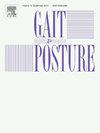Learning to suppress a balance recovery step: Implications for improving behavioral flexibility in a balance recovery stepping task
IF 2.2
3区 医学
Q3 NEUROSCIENCES
引用次数: 0
Abstract
Background
Research shows compensatory balance responses can be improved with training. The present study is a coincidental finding from a registered report that provides insight into trainability of response inhibition in a balance recovery stepping task.
Research question
Can suppression of response inhibition in a rapid balance recovery step be improved with training?
Methods
Young, healthy participants (N = 20) were released from a supported, forward lean to prompt a rapid balance recovery step. In most trials, participants were instructed to recover balance by quickly stepping forward (i.e., GO trials). However, in 20 % of the trials, a high-pitch tone was randomly played immediately after postural perturbation, signaling participants to suppress a step and relax into a catch harness (i.e., STOP). This balance recovery task was repeated on two separate days. Force plates measured GO reaction time post-perturbation and stepping errors on STOP trials.
Results
Task performance improved on the second day of testing, including faster steps (321 ± 37 ms vs. 348 ± 40 ms; p < 0.001) and more successful inhibition (46 ± 19% vs. 36 ± 19%; p = 0.005). Also, stop signal reaction time was faster on day two (286 ± 41 ms vs. 308 ± 46 ms; p = 0.041), suggesting the cognitive ability to suppress a highly prepotent action was directly influenced.
Significance
Our results build from past studies where balance reactions improve with practice and we now demonstrate that outright action cancellation within a balance recovery stepping task can be trained, suggesting behavioral flexibility can be improved without compromising response speed.
背景研究表明,代偿性平衡反应可以通过训练得到改善。本研究是一份注册报告中的偶然发现,它为平衡恢复步法任务中反应抑制的可训练性提供了见解。研究问题快速平衡恢复步法中反应抑制的抑制可以通过训练得到改善吗? 研究方法将年轻、健康的参与者(N = 20)从支撑的前倾状态中释放出来,以促使他们快速恢复平衡步法。在大多数试验中,参与者被指示通过快速向前迈步来恢复平衡(即 GO 试验)。然而,在 20% 的试验中,体位扰动后会立即随机播放高音调,提示参与者抑制迈步并放松到捕捉绳套中(即 STOP)。这项平衡恢复任务分别在两天内重复进行。结果任务表现在第二天的测试中有所改善,包括更快的步速(321 ± 37 ms vs. 348 ± 40 ms; p < 0.001)和更成功的抑制(46 ± 19% vs. 36 ± 19%; p = 0.005)。此外,停止信号的反应时间在第二天更快(286 ± 41 ms vs. 308 ± 46 ms; p = 0.041),这表明抑制高度前摄动作的认知能力受到了直接影响。重要意义我们的研究结果建立在过去研究的基础上,即平衡反应会随着练习而改善,我们现在证明了在平衡恢复步法任务中直接取消动作是可以训练的,这表明行为灵活性可以在不影响反应速度的情况下得到改善。
本文章由计算机程序翻译,如有差异,请以英文原文为准。
求助全文
约1分钟内获得全文
求助全文
来源期刊

Gait & posture
医学-神经科学
CiteScore
4.70
自引率
12.50%
发文量
616
审稿时长
6 months
期刊介绍:
Gait & Posture is a vehicle for the publication of up-to-date basic and clinical research on all aspects of locomotion and balance.
The topics covered include: Techniques for the measurement of gait and posture, and the standardization of results presentation; Studies of normal and pathological gait; Treatment of gait and postural abnormalities; Biomechanical and theoretical approaches to gait and posture; Mathematical models of joint and muscle mechanics; Neurological and musculoskeletal function in gait and posture; The evolution of upright posture and bipedal locomotion; Adaptations of carrying loads, walking on uneven surfaces, climbing stairs etc; spinal biomechanics only if they are directly related to gait and/or posture and are of general interest to our readers; The effect of aging and development on gait and posture; Psychological and cultural aspects of gait; Patient education.
 求助内容:
求助内容: 应助结果提醒方式:
应助结果提醒方式:


